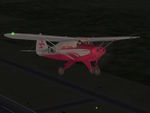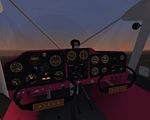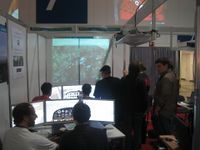FlightGear Newsletter August 2009
|
Welcome to the second edition of the FlightGear Newsletter. In this issue, we have a new GA aircraft in the hangar, a report from LinuxTag 2009, a description of a Tornado simulator, and some new custom scenery around Innsbruck, Austria.
The newsletter is still a bit thin on contributions, so if you'd like to contribute, please feel free to log onto the wiki and start editing the next edition here. We're still looking for a permanent (or even a temporary) newsletter editor, so if you'd like to get involved, have a look on the Forums ![]() .
.
What's New in CVS
Configurable Shaders
Tim Moore has committed a significant change to the graphics system that will allow much easier integration of OpenGL shaders within the simulator.
Shaders are small programs that run on your graphics card itself, and allow the simulator to do graphics operations that would otherwise be too computationally expensive. The current FG release (1.9.1) uses shaders for the forests of trees and 3D clouds.
This change represented a lot of work on the infrastructure of the project for long-term benefit. While there aren't any significant graphics changes based on this yet, we can expect a lot in the future, including integration of some nice water effects.
Generic Binary I/O protocol
The input and output code of FlightGear has been very flexible for many years by allowing for communications to (and from) files, serial ports and network sockets just by altering a command-line option.
In conjunction with that FlightGear has had support for a generic ASCII only input-output protocol handler for a number of years now. It is called 'generic' because it allows handling of just about any information in any form by altering a user modifiable xml configuration file. The functionality has been extended further by the possibility to define an offset and a multiplication factor. This approach might not cover every possible scenario but it will probably be good enough for most cases.
With the help of Anders Gidenstam the generic protocol has recently been extended to also support binary input and output. The data will be tightly packed in a packet that contains the requested data described in the configuration file. Supported types are: boolean values (8-bit), integer values (32-bit), floating point values (32-bit) and double precision floating point values (64-bit). Anders also added the option to support network byte ordering (big-endian) or system native byte-ordering which will save some processing time when only one type of system is used. To make it easier to see how the packet will be handled by FlightGear a utility called generic-protocol-analyze has been created which can be found in FlightGear/utils/xmlgrep. It outputs the data offset and size along with it's description.
New Wiki Articles
The wiki provides now a new article for aspiring core developers about extending the built-in Nasal scripting interpreter with custom extension functions: Howto:Extending Nasal. The Nasal documentation itself has been slightly reworked to provide a step by step introduction for users completely new to scripting or programming in general.
In the Hangar
There's a new aircraft in the CVS hangar - the PA 22-160 Tri Pacer. Created by Robert Leda (aka erobo) and Pawel Luchowski, this is a lovely GA aircraft and well worth having a flight in. If you enjoy VFR cross-country flying, or even simple IFR, and want to try something different to the Cessna 172, this is the plane for you.
The level of detail is very impressive - you must prime to start the engine (making sure the mixture is set), the sound varies depending on whether you've got the window open, and the doors slam shut. All in all, it's a great polished aircraft, and a fine addition to the hangar.
The FG hangar now has a very wide range of Piper aircraft, from the simple Cub, through the Cherokee Warrior II, Comanche 250, to the Seneca II. It is worth noting that the Warrior, Comanche and Seneca are all based on airframes flown by FG contributors in real life.
Useful Links
For those wanting to do some dead reckoning, this CRP5 E6B online calculator may be of interest. Get your stopwatch, chinagraph pencils, ruler and protractor ready!
There are a whole host of funky aviation converters here. Thanks to eeK on the forums for the links.
LinuxTag 2009
The 2009 edition of the LinuxTag has been concluded and the FlightGear hangar was there full of aircraft and pilots ! You could easily spot our stand since it seemed to me the most popular one, the idea to take a free virtual flight coupled with a free flight instructor was like honey for bears. Furthermore the hardware was impressive, 2 flight stations with 3 big monitors each and real controls were worth a try ! You could even track your flight through a projected mapserver on the wall.
We flew mostly around the Frankfurt area, where a highly detailed airport (still with a high fps rate) was the background of our participants. The favorite aircraft was the SenecaII as it was perfect to be flown with our equipment. Meanwhile in the forward station was easy to see some Eurocopter Bo105 pilot or F-14 Tomcat top gun enjoying carrier approaches.
But it was not just all flying and fun. At the stand you could talk to some code and model developers, discussing new features and wishes. There was a developers section too: Till was hacking an earth and sea textures generator to improve our virtual world terrain painting, applying shaders instead of fixed photos; early results where really interesting and I hope to see them soon in CVS.
The FlightGear guys prove themselves very friendly and always spoke in english in my presence. Martin Spott took care to manage an entrance pass for me and kept me informed prior to LinuxTag via Emails. This means you have no excuses to miss the event next year (At least only if you are not afraid of virtually flight !).
- Francesco Brisa
Tornado F3 Simulator
I had the very good fortune to use a genuine Panavia Tornado F3 simulator at RAF Leuchars in Scotland at the start of August.
I flew in from the south in my microlight, as part of a fly-in to the base. This was a rather unique event, as the last fly in to the base had been some 15 years before, and the RAF made us very welcome, with talks about their ATC and how to avoid the fast jets that fly near us (top tip - don't be at 250ft AGL - that's where they spend most of their time!).
The simulator itself did not have a moving platform, but did use a real cockpit, had a 120 degree field of view display and was used for training by the pilots, including interceptions and weapons training. The short sortie I flew took off from RAF Leuchars (EGQL) up the Firth of Forth, underneath the Forth Bridges, and then landing at Edinburgh (EGPH). The feeling of "being there" was quite remarkable, and it was a real privilege to have the opportunity to use it.
One of the things that struck me however, was that there was nothing there that was beyond the capabilities of FlightGear. The graphics were possibly slightly lower in quality (no scenery objects apart from the bridges) and the display technology was using DLP projectors (there's a description here). The key thing that made the experience so realistic was the wide field of view and the use of real hardware. I was sat in a real Tornado cockpit, the canopy was closed (with warning klaxon), the stick was heavy, and the throttles had to be moved appropriately for reheat or reverse thrust. So, perhaps its time to see if there are any real cockpits available...
Of course, none of this is news to the various people who are building fixed base simulators using FG as a software platform. There is a list of the known FG-based projects here, and almost certainly plenty more around.
-Stuart Buchanan
Innsbruck Gets A Face Lift
Custom scenery for the area in and around Innsbruck, Austria, is now available for downloading. The scenery currently covers a 1x1 degree area containing parts of Austria and Germany, and makes use of accurate data from the Corine Land Cover, and Open Street Map projects. Three airports lie within this area, Innsbruck LOWI towards the south western end in Austria, and EDHR + EDMK on the northern end in Germany. See the forum topic here ![]() for more details, pictures, and links to download the scenery.
for more details, pictures, and links to download the scenery.
See herefor a route that will take you on a nice tour around the scenery. The route starts and ends at Innsbruck LOWI, with visits to Lake Walchensee, Tegernsee, and Achensee. I recommend an amphibious plane such as the De Havilland Beaver on floats (--aircraft=dhc2F), so you can make stops at these beautiful alpine lakes and enjoy the view.
-Jacob Burbach
And Finally...
Check out the cockpit of an Airbus A380 and have a virtual tour here: http://www.airbus.com/store/mm_repository/cockpit_airbusA380/flash/cockpit1.htm








